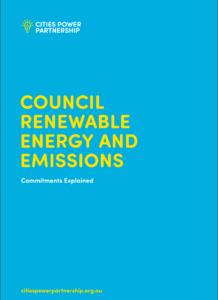Australia’s local councils are punching above their weight when it comes to tackling climate
change but it can be hard to understand what different council initiatives mean.
This article breaks down some widely used council jargon and explains what they actually mean.
1. 100% renewable energy council operations
When electricity supplied to council buildings and services is powered by 100% renewable energy.
This could be achieved in a number of ways:
– Rooftop solar or other on-site renewable energy (e.g. on leisure centres)
– Renewable energy contracted to meet council’s needs (either direct or through a power
purchase agreement)
– Purchasing 100% GreenPower
The City of Brisbane has 100% carbon neutral operations since 2017.
2. 100% renewable energy community
When the whole community – households, businesses, council operations – is powered by 100% renewable energy.
This could be achieved in a number of ways:
– Rooftop solar or other locally generated renewable energy (could be small or large scale
solar, wind power, geothermal, etc)
– Renewable energy contracted to meet the community’s needs
– Purchasing 100% GreenPower (this would need to cover all activities)
A range of local councils are aiming to power their communities by renewable energy.
Kununurra is already at 99%, Tyalgum aims to be 100% by 2020 and Yackandandah 100% by 2022.
3. Net zero emissions/carbon neutral council operations
When a council powers their operations with renewable energy and any remaining emissions are offset, such as through habitat preservation and savannah burning.
The City of Melbourne has had carbon neutral operations since 2012.
4. Net zero emissions community
When an entire community (not just council operations) is powered with renewable energy and any remaining emissions are offset (eg. through tree planting).
5. Zero net energy
A community that generates energy onsite, using clean renewable resources, in a quantity equal to or greater than the total amount of energy consumed in the community.
6. Power purchase agreement
Where a council commits to purchasing electricity from a wind or solar farm over a long-term period, often 5 to 10 years.
The Melbourne Renewable Energy Project are supporting the construction of an 80MW wind farm in regional Victoria. The wind farm will generate more than enough electricity to supply all the electricity needs of MREP members. Members of this project include Moreland, Yarra, Port Phillip and Melbourne councils, as well as RMIT and Melbourne University, Zoos Victoria, NAB, Australia Post, and others.
For a detailed explanation of the different types of contracting models that organisations,
including local councils, can enter into with renewable energy plants, see here.
7. Environmental upgrade agreement
An Environmental Upgrade Agreement (EUA) provides businesses with finance in order to upgrade commercial buildings and maximise a building’s energy efficiency.
Under an EUA, a lender provides loans for upgrades to commercial buildings to improve the
building’s energy efficiency, and the local council will collect the repayments for the loan through the rates system. This provides a more secure loan for lenders, who can then offer them at competitive rates and for longer terms.
Loans of up to 15 years are available for works and can include:
● energy and water efficiency
● renewable energy
● reducing greenhouse gas emissions
● preventing or reducing pollution
● reducing the use of materials
● recovery or recycling of materials
● monitoring environmental performance
● encouraging alternatives to car travel, such as walking and cycling.
As the loan is for longer term, the cost savings as a result of the upgrade can be used to repay the loan.
8. Revolving energy fund/green revolving fund
A revolving energy fund is an internal council fund that provides financing to implement emissions reduction projects. This includes energy efficiency, renewable energy, and other sustainability projects that generate cost savings.
These savings are tracked and used to replenish the fund for the next round of investments, thus establishing a sustainable funding cycle while cutting operating costs and reducing the environmental impact of an organisation.



